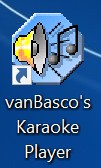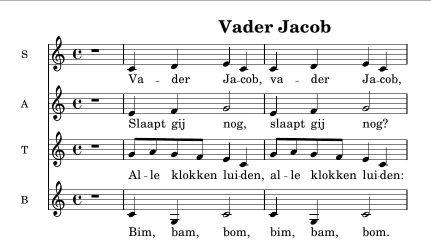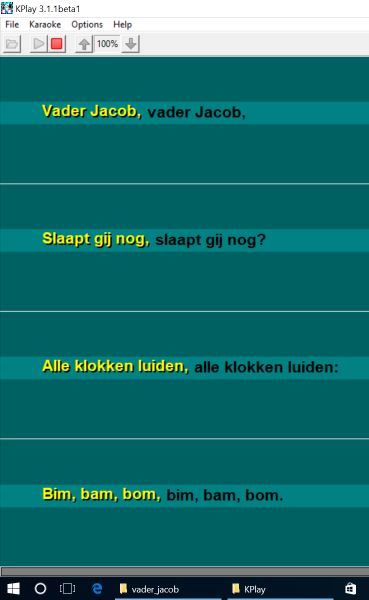
Lyrics / PolyText
No, I have not developed a Midi (Karaoke) Player myself. One reason
being that it has no sense to reinvent the wheel in the first place.
There
does exist a whole bunch of free & shareware players on the Word Wide Web.
This one used to be my favorite:

The player does not deal, though, with real polyphony
(J.S. Bach for example).
Current midi-karaoke players, even the excellent ones, cannot handle multiple
texts - PolyText - as is common especially in classical music.
Only lyrics defined by the Meta Lyric event
will be supported in future versions of the software (i.e. a standard set in the past by Tune 1000).
Wish list: real polyphony. And a midi karaoke player that displays e.g. SATB texts properly.
Perhaps the most well-known truly polyphonic song here in the Netherlands is
Vader Jacob.
It's not only PolyPhonic - melodies mixed - but it's also PolyTextual
- texts mixed - as exemplified in:
Va- der Ja- cob, | va- der Ja- cob,
slaapt gij nog, | slaapt gij nog?
Alle klokken lui-den, | alle klokken lui-den:
bim, bam, bom, | bim, bam, bom.
KAN extension
Let's display the first measure of the above fragment in an updated home-made
PianoRoll KAN (Klavar Ascii Notation) format:
478 : : : : : 9: :4 :2: : : : : : : | 8=Va 4=Slaapt_ 2=Al 1=Bim_
2 : : : : : 9: :4 : : : : : : : : |
478 : : : : : 9: :4 : :2: : : : : : | 2=le_
2 : : : : : : : : : : : : : : : |
478 : : :1: : :8: 4:2: : : : : : : | 8=der_ 4=gij_ 2=klok 1=bam_
2 : : :1: : :8: 4: : : : : : : : |
478 : : :1: : :8: 6: : : : : : : : | 2=ken_
2 : : : : : : : : : : : : : : : |
958 : : : : : 1: :A :4: : : : : : : | 8=Ja 4=nog_ 2=lui 1=bom_
2 : : : : : 1: : :4: : : : : : : |
958 : : : : : B: : :4: : : : : : : | 8=cob_ 2=den_
2 : : : : : : : : : : : : : : : |
This needs some explanation, right? The clue is that text shall be encoded
in exactly the same way as it is done with the notes. Essentially as it has
been accomplished for years with KlavarScribo, hence the name Klavar Ascii Notation (KAN).
In our case, we have 4 voices and 4 texts. These might be labeled as 0,1,2,3.
But two voices can be unisono (same note) and two texts can be the same
as well. In order to prevent confusion with notes and to save effort with
texts, instead of the 0,1,2,3 labeling, we do the following:
0 => 1 (= 20)
1 => 2 (= 21)
2 => 4 (= 22)
3 => 8 (= 23)
Because then all possible combinations of the note parts can be created,
and they are unique:
0 1 1 1 1 1 1 1 1
1 2 2 2 2 2 2 2 2
2 4 4 4 4 4 4 4 4
3 8 8 8 8 8 8 8 8
-----------------------------------------------
0 1 2 3 4 5 6 7 8 9 A B C D E F
Now take a look again at the above KAN fragment and mind the notation '9'
where '8' and '1' are unisono, '6' where '4' and '2' are unisono, 'A' where
'8' and '2' are unisono, 'B' where '8' and '2' and '1' are unisono.
It's
time for trying to understand the full KAN score
for our Vader Jacob canon. In this KAN score it
is also demonstrated how equal texts are handled. At the end of the song we
have arranged that all voices have the same notes and the same text as well:
958 : : : : : F: : : : : : : : : : | F=Bim_
2 : : : : : : : : : : : : : : : |
958 : : :F: : : : : : : : : : : : | F=bam_
2 : : : : : : : : : : : : : : : |
1918 : : : : : F: : : : : : : : : : | F=bom_
2 : : : : : : : : : : : : : : : |
For the sake of completeness, there is also a track
for defining instruments and properties like volume, bending, sustain, etcetera.
And it's handsome to create the final midifile by a script instead of typing the same commands by hand every time again.
So far so good,
but how does all this translate into a midifile, especially the PolyText part?
With current (2017) midi-karaoke players, the Midi Meta Event Lyric is
(commonly but not exclusively) employed for lyrics. It has the following
format:
$FF <type> <length> <text>
$FF $05 <length> <text>
There has not been defined a Midi Meta Event for PolyText, but upon carefully
reading the above
specifications
it will be seen that the following Meta Events are not yet defined:
<type> = $10 ... $1F
$FF $10 , $FF $11 , $FF $12 , $FF $13 , $FF $14 , $FF $15 , $FF $16 , $FF $17
$FF $18 , $FF $19 , $FF $1A , $FF $1B , $FF $1C , $FF $1D , $FF $1E , $FF $1F
In order to preserve the idea that a note can be in 16 channels, we have opted
for giving a similar meaning to these hitherto unemployed Meta Events:
$FF <type> <length> <text>
$FF $1<channel>(PolyText) <length> <text>
Then the translation of the above Vader Jacob fragment into a textual
equivalent of the midifile's content is rather straightforward. It is noticed
that the channels of the PolyText events are an exact match with the channels
of the corresponding notes, as intended by our design. (And in case somebody
cares, here is the real hex-dump of this part of
the midifile too):
Meta $13(PolyText) Va
Meta $12(PolyText) Slaapt_
Meta $11(PolyText) Al
Meta $10(PolyText) Bim_
Note ch$0 60(C5) 120
Note ch$1 67(G5) 120
Note ch$2 64(E5) 120
Note ch$3 60(C5) 120
478
Note ch$1 67(G5) 0
2
Meta $11(PolyText) le_
Note ch$1 69(A5) 120
478
Note ch$3 60(C5) 0
Note ch$2 64(E5) 0
Note ch$1 69(A5) 0
Note ch$0 60(C5) 0
2
Meta $13(PolyText) der_
Meta $12(PolyText) gij_
Meta $11(PolyText) klok
Meta $10(PolyText) bam_
Note ch$0 55(G4) 120
Note ch$1 67(G5) 120
Note ch$2 65(F5) 120
Note ch$3 62(D5) 120
478
Note ch$1 67(G5) 0
2
Meta $11(PolyText) ken_
Note ch$1 65(F5) 120
478
Note ch$3 62(D5) 0
Note ch$2 65(F5) 0
Note ch$1 65(F5) 0
Note ch$0 55(G4) 0
2
Meta $13(PolyText) Ja
Meta $12(PolyText) nog_
Meta $11(PolyText) lui
Meta $10(PolyText) bom_
Note ch$0 60(C5) 120
Note ch$1 64(E5) 120
Note ch$2 67(G5) 120
Note ch$3 64(E5) 120
958
Note ch$3 64(E5) 0
Note ch$1 64(E5) 0
2
Meta $13(PolyText) cob_
Meta $11(PolyText) den_
Note ch$1 60(C5) 120
Note ch$3 60(C5) 120
958
Note ch$3 60(C5) 0
Note ch$2 67(G5) 0
Note ch$1 60(C5) 0
Note ch$0 60(C5) 0
2
With the present approach, as explained above, PolyText is represented by our
generalized Lyric event, hence corresponding with at most 16 polyphonic midi
channels, exactly as with the voices in music.
So a major advantage of the META proposal is that there is a clear
one-to-one mapping between text and voice :
MIDI <channel> <==> META <type>
This makes it easy, for example, to mute a channel together with its text.
However, there is not yet a midi player who can display such PolyText.
In order to display songtext with existing midi-karaoke players, a program (app)
called POLY2LY has been developed.
Just define the part that you want to sing, and the accompanying song text shall
be properly displayed by the player. Only one part at a time, though:
part 0 (1) ,
part 1 (2) ,
part 2 (4) ,
part 3 (8) . Looks like this (for part 0):
 But there is another way. In general, there are two sorts of midi music packages:
(1) main purpose is audio: midi music (2) main purpose is visual:
music score. With the latter, the need for PolyText always has been more urgent
than with the former. With music score, PolyText has been present for quite some
time and the problem of its presence has been solved in a different way. Instead
of assigning a different channel to a different text, as has been done with our
META proposal, different tracks are assigned to
PolyText. Though it is a common feature of many music score oriented packages,
we shall call this the
LilyPond solution for future reference.
But there is another way. In general, there are two sorts of midi music packages:
(1) main purpose is audio: midi music (2) main purpose is visual:
music score. With the latter, the need for PolyText always has been more urgent
than with the former. With music score, PolyText has been present for quite some
time and the problem of its presence has been solved in a different way. Instead
of assigning a different channel to a different text, as has been done with our
META proposal, different tracks are assigned to
PolyText. Though it is a common feature of many music score oriented packages,
we shall call this the
LilyPond solution for future reference.
Having said all this, let's dive into the deep and compose an input file for LilyPond,
thus obtaining free music score for everyone's "Vader Jacob":
Execution of the above .LY file as input within the LilyPond system results in music score
(PDF) output looking like this:
And in a midifile as well. The structure of this midifile
becomes obvious from its textual (DTN) representation. It is
seen that the PolyText lyrics are indeed scattered into different tracks, 2,4,6,8 in our case.
A major drawback of the LilyPond solution is that there is no clear one-to-one
mapping between text and voice (such as is provided with the META proposal). Looking like this:
Track 0
Tempo events etc.
Track 1
Melody part 1
Track 2
Text part 1
Track 3
Melody part 2
Track 4
Text part 2
Track 5
Instrumental
etcetera
It difficult - if not impossible, for example to mute a channel together with its text.
There is an easy remedy for this, namely putting lyrics and accompanying melody into the same track:
Track 0
Tempo events e.d.
Track 1
Melody part 1
Text part 1
Track 2
Melody part 2
Text part 2
Track 3
Instrumental
etcetera
Though this is slightly different from the LilyPond solution.
KPlay prototype
However, the content of the midifile can be heard and seen nowadays by means of a prototype
PolyText player (yes!) that understands the LilyPond solution. The prototype player,
called KPlay, has been developed by the music composer
and program developer Edwin van Veldhoven.
Output of KPlay is looking like this: 
Still Another Proof of Concept
The above is all nice and easy, but there exist other ways of visualizing the lyrics. Like this:
========================================================================
Vader Jacob Vader Jacob Slaapt gij nog Slaapt gij nog Al_____le
Va_____der Ja__cob Va_____der Ja__cob Slaapt
Va________
========================================================================
klokken lui_den Al_____le klokken lui_den Bim bam bom Bim
gij nog Slaapt gij nog Al_____le klokken lui_den Al__
der Ja__cob Va________der Ja__cob Slaapt gij nog Slaa
Va________der Ja__cob Va__
========================================================================
bam bom Va________der Ja__cob Va________der Ja__co
___le klokken lui_den Bim bam bom Bim bam bom
pt gij nog Al_____le klokken lui_den Al_____le klokken lui_de
______der Ja__cob Slaapt gij nog Slaapt gij nog
========================================================================
b Slaapt gij nog Slaapt gij nog Al_____le klokken
Va________der Ja__cob Va________der Ja__cob Slaapt gij
n Bim bam bom Bim bam bom Va________der
Al_____le klokken lui_den Al_____le klokken lui_den Bim bam
========================================================================
lui_den Al_____le klokken lui_den Bim bam bom Bim ba
nog Slaapt gij nog Al_____le klokken lui_den Al_____le kl
Ja__cob Va________der Ja__cob Slaapt gij nog Slaapt gi
bom Bim bam bom Va________der Ja__cob Va________de
========================================================================
m bom Bim bam bom Bim bam bom Bim
okken lui_den Bim bam bom Bim bam bom Bim
j nog Al_____le klokken lui_den Al_____le klokken lui_den Bim
r Ja__cob Slaapt gij nog Slaapt gij nog Al__le
========================================================================
bam bom Bim bam bom Bim bam bom Bim bam bom
bam bom Bim bam bom Bim bam bom Bim bam bom
bam bom Bim bam bom Bim bam bom Bim bam bom
klokken lui_den Al__le klokken lui_den Bim bam bom Bim bam bom
========================================================================
More examples
Back to my HomePage.




